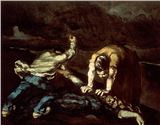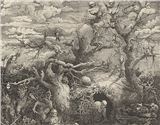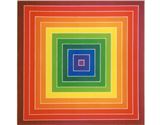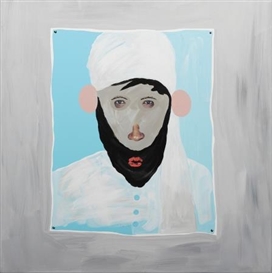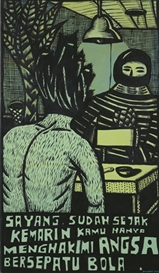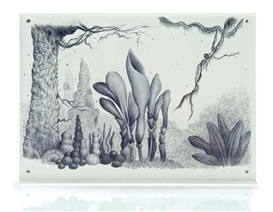The Jakarta Biennale XIII Seizing the Present
The Jakarta Biennale’s Fluid Zone exhibitions were well worth the long wait. Crisp, focused and with a clear sense of spatial proportions, the
Carla Bianpoen / C-Arts
Mar 01, 2009
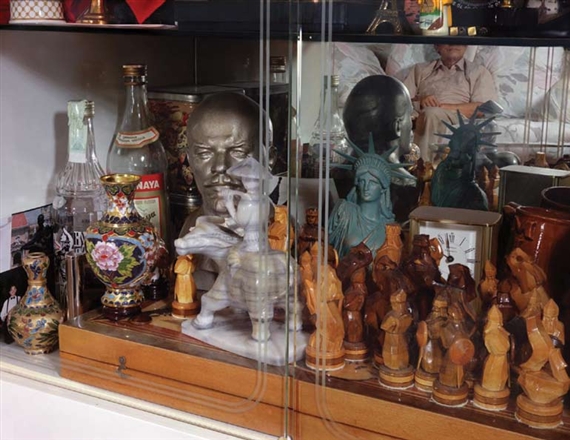
The exhibitions were a testimony to the contemporary, inspired by the past, present and future. National boundaries were a less important issue, though memory and history remain enduring sources of inspiration to create art works matching the spirit of the present time.
One such work is Java: The War of Ghosts, an installation by Kuswidananto aka Jompet—an artist who has for some time drawn attention with his ability to combine visual and audio techniques and materials in his fascinating art works inspired by Javanese culture.
Jompet takes palace soldiers as a symbol of the Javanese inclination toward syncretism, merging divergent beliefs and cultures. Consisting of drums beating mechanically with figures of keraton guards indicated by Javanese—Europe-inspired—jackets in place of the bodies, shorts and European boots in place of the feet and legs, and European rifles held by imaginary hands; while the hats are Java-inspired.
Iswanto Hartono’s installation of large prints of colonial illustrations covering the wall in the hall of the gallery, as well as a canal structure with toy boats sailing in flowing water refer to the hegemony of the Dutch East India Company (Vereenigde Oost-Indische Compagnie) or VOC, and the canal system that the Dutch adapted from Amsterdam in Batavia (now Jakarta).
But it is personal memories that are the most moving as revealed in the installation of 132 handmade passports by Tintin Wulia. Simple and less technical, but coming from a depth of thought, experience and imagination, it is titled (Re) collection of Togetherness- stage 4. The installation is a gripping testimony of the artist’s exploration of identity as a Chinese-Indonesian who has endured discrimination and insecurity. Passports are artificial constructions which can never give enough information about one’s real identity; hence her desire to be free as a citizen of the world.
Roslisham Ismail (known as Ise to his friends) from Malaysia uses dialog from a movie by P. Ramlee, an actor and movie maker whose fame stretches from Malaysia to Singapore and Indonesia. Dialogs of Hang Tuah the Malay hero who is known for saying “Takkan Melayu hilang di dunia” (Never shall the Malay vanish from the face of the earth) are reenacted in Chinese. Language here is a metaphor for the artist’s stance.
Language as a metaphor is also used by Ming Wong from Singapore, an artist, performer and playwright, who re-enacts Ramlee’s frank depictions of social and sexual mores from the 50s to 70s, using Malay language. Four Malay Stories presented in this exhibition is a four channel video installation with audio described by Eugene Tan on page 53 of Meanwhile, the work by RE Hartanto also goes back to history, as described in the same article by Eugene Tan in this magazine.
Violence as presented by Filipina artist Lyra Garcellano is subtle, but no less poignant when two of her works are set side by side: A Day in the Life of the Other, featuring tiny little soldiers, and Culde- Sac a work featuring dozens of digital prints of women’s faces. And Malaysia’s Nadiah Bamadhaj’s stirring charcoal painting Lewat Gapura, alludes to her feelings of remaining a stranger in the Yogya environment where she lives. She depicts herself as Medusa, a gorgon, chthonic female monster in Greek mythology; who would turn those who looked upon her into stone. The remarkable feature of this painting is the use of torn paper to build up her image, thus achieving the illusion of a sculpture.
In contrast with the subtleties in the above works, David Griggs’ paintings in the Bleeding Club series, show a more direct mode of expression.
Almost all of the works exhibited in the second venue, the lower ground floor of the Grand Indonesia East Side Shopping Mall were interesting, but standing out here was the somber five single channel video installation including a table of dozens of photographs of dolls titled The Meeting by Singapore-born Donna Ong, mentioned in Eugene Tan’s article in this magazine. While it refers to a project in her residence in Japan, dolls also belong to dreams she had as a child. Another prominent work was the satirical installation of giant elephants, like in a circus, and a mural with text by the multi-talented Eko Nugroho, a critique on human behavior in times of crisis. The sculptures by Wiyogo Muhardanto were striking, not only those including vehicles, but also his show case of “branded bags” with the title Buy Two, Get One Free with seemingly subtle nipples that became realist breasts when photographed. There was also the video by Porntaweesak Rimsakul’s single channel video The Story of Teapot and Sylvain Sailly’s lyrical animation of falling paper which was inspired by the falling of frangipani leaves, Hoang Dong Cam’s Gone Table Gone, and many more.
Organized by the Jakarta Art Council, this visionary biennale exhibition will be an important legacy of the current council when its term ends in July 2009.
What will happen in the next Jakarta biennale, is hard to say. But the young visionary, curator Agung Hujatnikkajennong, has a follow up proposal in reserve, just in case the next board of the Jakarta Art Council entertains the same vision. Only time will tell.


